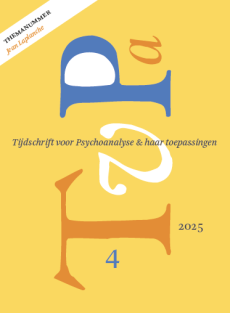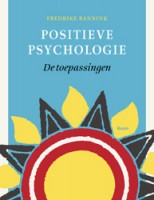Dyscivilisatie en dysmentalisatie
Summary
Is organized mass violence and destruction a manifestation of ‘modernity’ or rather its total opposite, ‘a breakdown of civilization'? The concept of ‘dyscivilization’ transcends this opposition. At the core of the civilizing process, a contrary current sometimes manifests itself, allowing extreme violence on a mass scale to gravitate towards specific categories of people, while civilized relations and modes of expression are maintained in other sections of society. Compart-mentalization is both the social and the psychic mechanism par excellence in a dyscivilizing society. To maintain it requires both rigid separations and carefully staged transitions between the civilized and decivilized emotional and interactive domains.
The author argues that for the perpetrators of destructive violence a developmental defect in mentalizing capacity or reflective function (‘non-mentalization’) strongly facilitates the psychological separation of their experiences in the sites of destruction from all other mental processes or social encounters. For the majority of people who are not victims of barbarism, have no participation in it and are not engaged in opposing it, the integration of genocidal violence into their personal and collective self-image is accompanied by a selective decline in mentalizing capacity (‘desmentalization’). Both the psychological and social origins of these disorders in mentalization (‘dysmentalization’) are described.
Literatuur
- Arendt, H. (1994), Eichmann in Jerusalem. A report on the banality of evil (Postscript). Penguin Books, New York.
- Borofsky, G.L., en D.J. Brand (1980), Personality organization and psychological function. The Rorschach data. In: J.E. Dimsdale (red.), Survivors, victims, and perpetrators. Essays on the Nazi Holocaust. Hemisphere Publishing Corporation, Washington, p. 359-403.
- Bowlby, J. (1973), Attachment and loss. Vol. II. Separation, anxiety, and anger. Basic Books, New York.
- Broszat, M., (red.) (1981), Kommandant in Auschwitz. Autobiographische Aufzeichnungen des Rudolf Höss. Deutscher Taschenbuch Verlag, München.
- Chandler, M.J., K. Paget en D. Koch (1978), The child’s demystification of psychological defense mechanisms. Developmental Psychology 14, p. 197-205.
- Clyman, R.B. (1991), The procedural organization of emotions: a contribution from cognitive science to the psychoanalytic theory of therapeutic action. Journal of the American Psychoanalytic Association 39 Suppl., p. 349-382.
- Cohen, N.J., en H. Eichenbaum (1993), Memory, amnesia and the hippocampal system. MIT Press, Cambridge MA.
- Deben-Mager, M. (1999), Nieuwe theoretische grondslagen van de psychoanalyse en hun betekenis voor het kind in de ouder. In: H. Groen-Prakken en A. Ladan (red.). Het kind in de ouder. Over de invloed van de eigen kindertijd op het ouderschap. Van Gorcum, Assen, p. 84-97.
- Dimsdale, J.E. (1980), Excerpts from the autobiography of Rudolf Hoess. In: J.E. Dimsdale (red.). Survivors, victims, and perpetrators. Essays on the Nazi Holocaust. Hemisphere Publishing Corporation, Washington, p. 289-304.
- Fazio, R., J.R. Jackson, B. Dunton en C.J. Williams (1995), Variability in automatic activation as unobstructive measure of racial attitudes: A bona fide pipeline? Journal of Personality and Social Psychology 69, p. 1013-1027.
- Fonagy, P. (1991), Thinking about thinking: Some clinical and theoretical considerations in the treatment of a borderline patient. International Journal of Psychoanalysis 72, p. 1-18.
- Fonagy, P. (1993), Psychoanalytic and empirical approaches to developmental psychopathology: an object-relations perspective. Journal of the American Psychoanalytic Association 41, p. 245-260.
- Fonagy, P. (1999), Memory and therapeutic action. International Journal of Psychoanalysis 80, p. 215-223.
- Fonagy, P., en G.S. Moran (1991), Understanding psychic change in child psychoanalysis. International Journal of Psychoanalysis 72, p. 15-22.
- Fonagy, P., G.S. Moran en M. Target (1993), Aggression and the psychological self. International Journal of Psychoanalysis 74, p. 471-485.
- Fonagy, P., H. Steele, G. Moran, M. Steele en A. Higgitt (1991), The capacity for understanding mental states: the reflective self in parent and child and its significance for security of attachment. Infant Mental Health Journal 13, p. 200-217.
- Fonagy, P., M. Steele, H. Steele, A. Higgitt en M. Target (1994), The theory and practice of resilience. Journal of Child Psychology and Psychiatry 15, p. 231-257.
- Fonagy, P., M. Steele, H. Steele en M. Target (1997a), Reflective-functioning manual. for application to adult attachment interviews. Version 4.1. Unpublished manuscript. Psychoanalysis Unit. Sub-department of Clinical Health Psychology. University College London.
- Fonagy, P., M. Target, M. Steele, H. Steele, T. Leigh, A. Levinson en R. Kennedy (1997b), Morality, disruptive behavior, borderline personality disorder, crime and their relationships to security of attachment. In: L. Atkinson en K. Zucker, K. (red.), Attachment and Psychopathologie. Guildford Press, New York, p. 223-274.
- George, C, N. Kaplan en M. Main (1985), The Adult Attachment Interview. Unpublished manuscript. Department of Psychology, University of California at Berkeley.
- Gomperts, H.A. (2000), Een kern van waarheid. Van Oorschot, Amsterdam.
- Hummelen, J.W. (1997), Splitsing. Het psychoanalytische concept en de mogelijkheid het afweermechanisme splitsing betrouwbaar vast te stellen. De Tijdstroom, Utrecht.
- James, W. (1890), Principles of psychology. Holt, New York.
- Kagan, J. (1989), Unstable ideas: temperament, cognition and self. Harvard Press, Cambridge MA.
- Kandel, E.R. (1999), Biology and the Future of Psychoanalysis: A new intellectual framework for psychiatry revisited. American Journal of Psychiatry 156 (4), p. 505-524.
- Kernberg, O.F. (1966), Structural derivatives of object relationships. International Journal of Psychoanalysis 47, p. 236-353.
- Ladan, A. (1999), Het kind in de volwassene: dood of levend? In: H. Groen-Prakken en A. Ladan (red.). Het kind in de ouder. Over de invloed van de eigen kindertijd op het ouderschap. Van Gorcum, Assen, p. 4-20.
- LeDoux, J. (1996), The emotional brain. Simon & Schuster, New York.
- Main, M., en R. Goldwyn (1993), Adult attachment rating and classification systems. In: M. Main (red.), A typology of human attachment organization assessed in discourse, drawings and interviews. Cambridge University Press, New York.
- Main, M. (1993), Discourse, prediction, and recent studies in attachment: implications for psychoanalysis. Journal of the American Psychoanalytic Association 41, p. 209-244.
- Main, M. (1995), Recent studies in attachment; overview, with selected implications for clinical work. In: S. Goldberg, R. Muir en J. Kerr (red.), Attachment theory. Social, developmental and clinical perspectives. The Analytic Press, New York.
- Pally, R. (1997), Memory: brain systems that link past, present and future. International Journal of Psychoanalysis 78, p. 1223-1234.
- Premack, D., en G. Woodruff (1978), Does the chimpanzee have a theory of mind? The Behavioral and Brain Sciences 4, p. 515-526.
- Squire, L.R. (1987), Memory and Brain. Oxford University Press, New York.
- Sroufe, L.A., E.A. Carlson, A.K. Levy en B. Egeland (1999), Implications of attachment theory for developmental psychopathology. Development and Psychopathology 11, p. 1-13.
- Sroufe, L.A., B. Egeland en T. Kreutzer (1990), The fate of early experience following developmental change: longitudinal approaches to individual adaptation in childhood. Child Development 61, p. 1363-1373.
- Stern, D.N. (1985), The interpersonal world of the infant. Basic Books, New York.
- Stern, D.N. (1994), One way to build a clinically relevant baby. Infant Mental Health Journal 15, p. 36-64.
- Stern, D.N., L.W. Sander, J.P. Nahum, K.L. Harrison, A.C. Morgan, N. Bruschweiler-Stern, E.Z. Tronick (1998), Non-interpretative mechanisms in psychoanalytic therapy. The ‘something more’ than interpretation. International Journal of Psychoanalysis 79, p. 903-921.
- Swaan, A. de (1997), Uitdijende kringen van desidentificatie: gedachten over Rwanda. Amsterdams Sociologisch Tijdschrift 24 (1), p. 3-23.
- Swaan, A. de (1999), Dyscivilisatie, massavernietiging en de staat. Amsterdams Sociologisch Tijdschrift 26 (3), p. 289-301.
- Tulving, E., en D.L. Shacter (1990), Priming and human memory systems. Science 247, p. 301-306.
- Winnicott, D.W. (1967), Mirror-role of the mother and family in child development. In: P. Lomas (red.), The predicament of the family: a psycho-analytical symposium. Hogarth Press, Londen.
 © 2009-2025 Uitgeverij Boom Amsterdam
© 2009-2025 Uitgeverij Boom Amsterdam
ISSN 1382-516x
De artikelen uit de (online)tijdschriften van Uitgeverij Boom zijn auteursrechtelijk beschermd. U kunt er natuurlijk uit citeren (voorzien van een bronvermelding) maar voor reproductie in welke vorm dan ook moet toestemming aan de uitgever worden gevraagd:
Behoudens de in of krachtens de Auteurswet van 1912 gestelde uitzonderingen mag niets uit deze uitgave worden verveelvoudigd, opgeslagen in een geautomatiseerd gegevensbestand, of openbaar gemaakt, in enige vorm of op enige wijze, hetzij elektronisch, mechanisch door fotokopieën, opnamen of enig andere manier, zonder voorafgaande schriftelijke toestemming van de uitgever.
Voor zover het maken van kopieën uit deze uitgave is toegestaan op grond van artikelen 16h t/m 16m Auteurswet 1912 jo. Besluit van 27 november 2002, Stb 575, dient men de daarvoor wettelijk verschuldigde vergoeding te voldoen aan de Stichting Reprorecht te Hoofddorp (postbus 3060, 2130 KB, www.reprorecht.nl) of contact op te nemen met de uitgever voor het treffen van een rechtstreekse regeling in de zin van art. 16l, vijfde lid, Auteurswet 1912.
Voor het overnemen van gedeelte(n) uit deze uitgave in bloemlezingen, readers en andere compilatiewerken (artikel 16, Auteurswet 1912) kan men zich wenden tot de Stichting PRO (Stichting Publicatie- en Reproductierechten, postbus 3060, 2130 KB Hoofddorp, www.cedar.nl/pro).
No part of this book may be reproduced in any way whatsoever without the written permission of the publisher.
Nieuwsbrief Boom Psychologie
Meld u nu aan en ontvang maandelijks de Boom Psychologie nieuwsbrief met aantrekkelijke aanbiedingen en de nieuwe uitgaven.
Aanmelden


